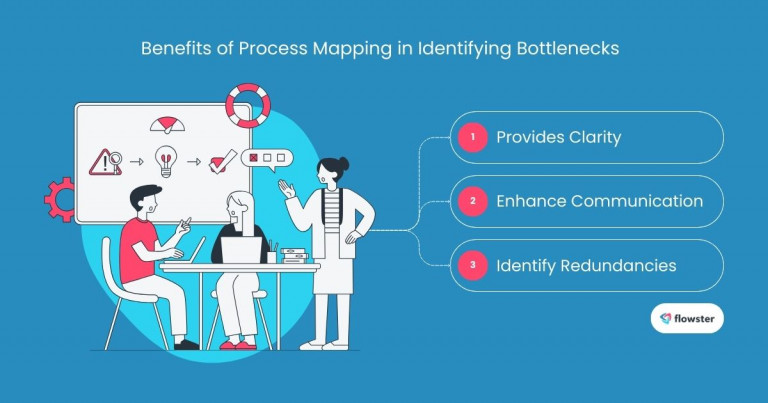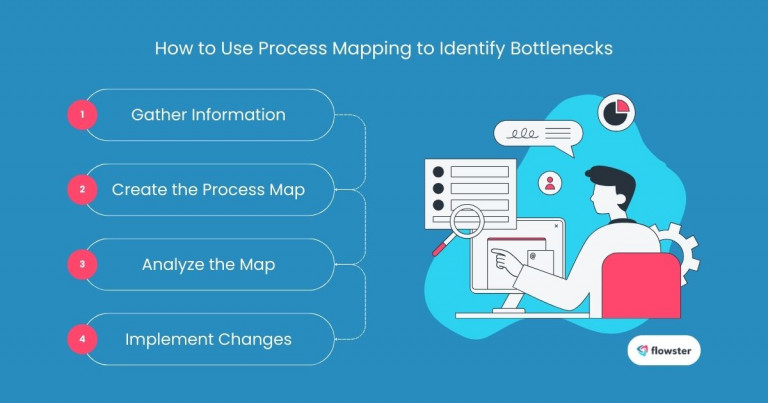Managing a small or medium-sized business often requires juggling multiple tasks and deadlines. You’re managing multiple tasks, deadlines, and employees, and sometimes, things just don’t flow as smoothly as you’d like. If you’ve experienced frustrating delays or inefficient workflows, you might be dealing with bottlenecks.
That’s where process mapping comes in. This simple yet powerful tool helps visualize workflows, making it easier to spot and address issues. In this article, we will explore how process mapping can help identify bottlenecks in your business processes, leading to improved efficiency and productivity.
Article Outline
Understanding Bottlenecks in Business Processes
To effectively resolve bottlenecks, it’s essential to understand what they are and how they impact your business. In this section, we’ll define bottlenecks and explore their consequences, giving you a clear picture of what to look out for in your workflows.
What is a Bottleneck?
A bottleneck occurs when a stage in your workflow slows down or impedes the overall process. This could be due to limited resources, inefficient procedures, or lack of communication. Identifying these slow points is crucial because they can significantly affect your team’s performance and lead to missed opportunities.
Consequences of Bottlenecks
Bottlenecks can have a ripple effect throughout your organization. They often lead to increased operational costs, lower productivity, and diminished customer satisfaction. When products or services are delayed, it can frustrate customers and harm your reputation, making it vital to identify and address these issues promptly.
By recognizing what bottlenecks are and the problems they can cause, you’re better equipped to take corrective action. In the next section, we’ll dive into the role of process mapping and how it can help you identify these bottlenecks effectively.
If you want to learn more about workflow mistakes and how to fix them, check out this article: Workflow Management Mistakes and How to Fix Them.

The Role of Process Mapping
Now that we understand what bottlenecks are and their consequences, let’s explore the role of process mapping. This diagnostic tool serves as a visual aid, helping you organize and analyze your workflows. By mapping out your processes, you can identify inefficiencies and areas in need of improvement.
What is Process Mapping?
Process mapping is the visual representation of the steps involved in a process. It breaks down complex workflows into easy-to-understand diagrams. This can include flowcharts, swimlane diagrams, or other formats that make it simple to see how tasks flow from one stage to another.
Benefits of Process Mapping
The benefits of process mapping are numerous. First, it provides clarity by showcasing the entire workflow, making it easier to spot bottlenecks. Second, it enhances communication among team members, as everyone can see their roles and responsibilities within the process. Lastly, it facilitates the identification of redundancies—unnecessary steps that can be eliminated to streamline operations.
Armed with a clear understanding of how process mapping can illuminate your workflows, we can now move on to the practical steps for using this tool to identify bottlenecks effectively.
If you’re interested in learning more about business process mapping, check out this article: Business Process Mapping.

How to Use Process Mapping to Identify Bottlenecks
With a grasp of what process mapping is and its benefits, let’s delve into the practical steps for using this technique to pinpoint bottlenecks in your business processes. By following these steps, you can effectively visualize workflows and address inefficiencies.
Step 1: Gather Information
The first step in process mapping is to collect data about your existing processes. This involves talking to team members who are directly involved in the workflows. Their insights can reveal pain points that may not be obvious from a higher-level perspective. Gathering this information sets the foundation for an accurate and comprehensive map.
Step 2: Create the Process Map
Once you have the necessary information, it’s time to create the process map. Choose a format that best represents the workflow, whether it’s a flowchart or a swimlane diagram. Many online tools, including Flowster, offer templates to make this easier. Visualizing the process helps you see how tasks are interconnected and where delays may occur.
Step 3: Analyze the Map
After the map is created, it’s time to analyze it. Look for areas where steps take longer than expected or where tasks pile up. Ask specific questions: Are there too many approvals needed? Is communication slow? This analysis will help highlight bottlenecks that need attention.
Step 4: Implement Changes
Once you’ve identified bottlenecks, prioritize them and develop an action plan to address them. This may involve streamlining certain steps, improving communication, or reallocating resources. Remember, the goal is to create a more efficient workflow that supports your business’s growth.
With these steps, you’re well-equipped to leverage process mapping in identifying bottlenecks. Next, we’ll explore common issues found in processes and how to tackle them effectively.
If you want to enhance your understanding of process mapping in task management, check out this article: Process Mapping in Task Management: Boost Productivity.
Capture Your Processes in Minutes!
Common Bottlenecks and How to Address Them
As we continue exploring how process mapping can benefit your business, it’s essential to identify common bottlenecks that many organizations face. By recognizing these specific issues, you can apply targeted solutions that lead to more efficient operations.
Examples of Common Bottlenecks
Bottlenecks can manifest in various ways within your business processes. Here are a few frequent culprits:
- Overloaded Workstations: When certain tasks require more attention and resources than others, it can create delays. For instance, if a single employee is responsible for critical approvals, it can halt progress for the entire team.
- Inefficient Communication Channels: Poor communication can lead to misunderstandings and delays. For example, using several disconnected platforms for updates can make it challenging to keep everyone on the same page.
- Delays Due to Approvals or Feedback Loops: Extended approval processes can slow down project timelines. If several levels of authorization are needed, it can cause frustration and hinder progress.
Solutions Through Mapping
Process mapping can help you address these common bottlenecks effectively. For overloaded workstations, mapping can reveal where workloads are imbalanced, allowing for better resource allocation. In cases of inefficient communication, a clearer visual representation of the workflow can highlight where integration is needed to streamline interactions.
For approval delays, mapping can simplify the process by identifying unnecessary steps. By revising these workflows, you can make approvals faster and more efficient.
Understanding these common bottlenecks empowers you to take action and enhance your processes. Next, we’ll discuss how to get started with your own process mapping journey and implement effective changes in your business.
If you’re looking for practical advice on how to update your business processes, check out this article: 6 Must-Know Tips for Updating Business Processes.
Flowster's AI-Driven Automation
Conclusion: Take Action with Process Mapping to Eliminate Bottlenecks
In this article, we’ve explored how process mapping can help identify bottlenecks within your business workflows. We’ve defined what bottlenecks are and discussed their consequences, highlighted the role of process mapping and provided practical steps for using this powerful tool. Additionally, we examined common bottlenecks and how to address them effectively.
Now it’s time to take action! Start mapping your own business processes today. Visualizing your workflows will not only help you identify inefficiencies but also set the stage for continuous improvement. To make this easier, you can access free workflow templates from Flowster, which will help you get started quickly.
Check out the templates here: Free Workflow Templates from Flowster. By taking this step, you’ll be on your way to enhancing efficiency and boosting productivity in your business!




